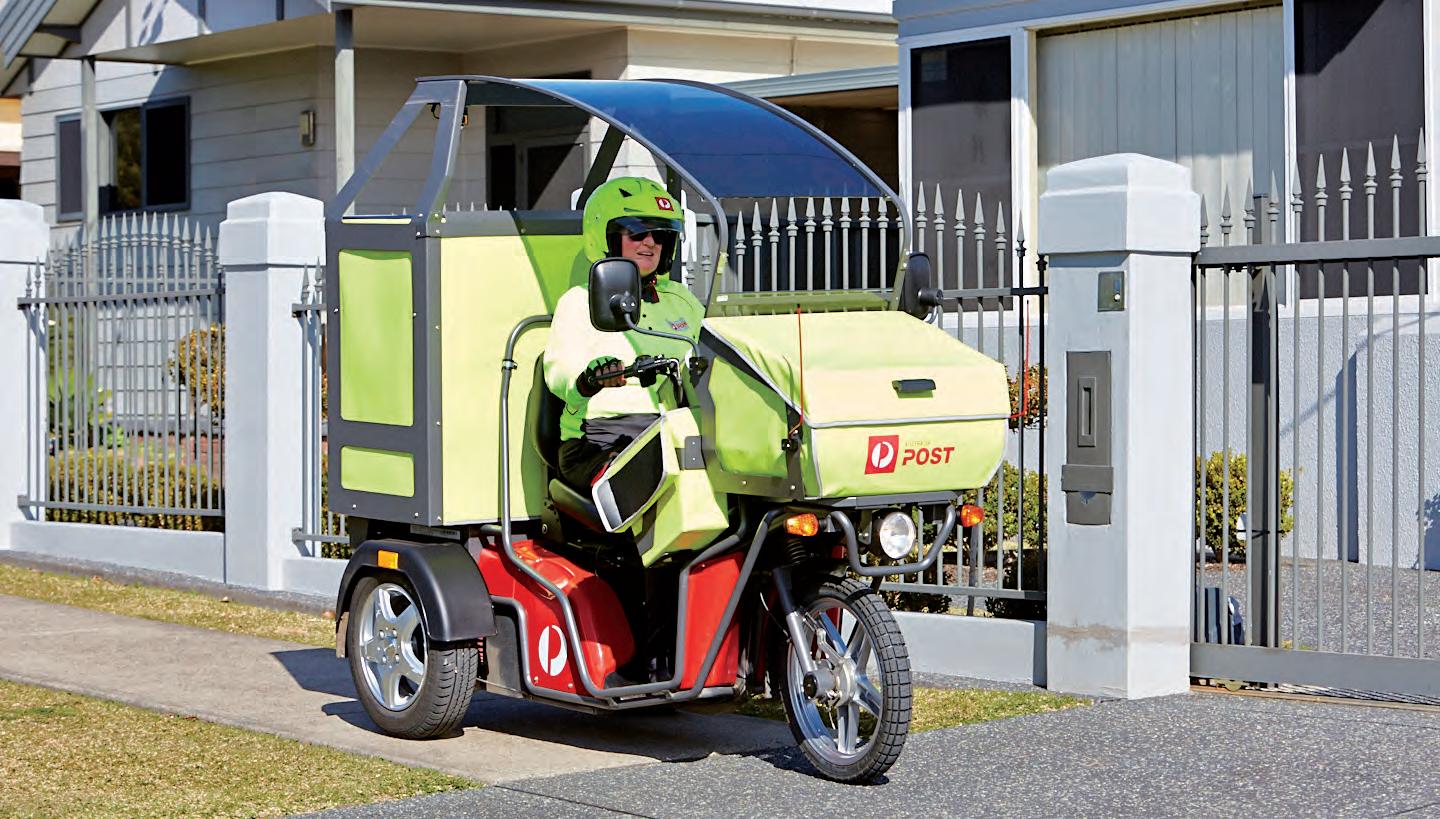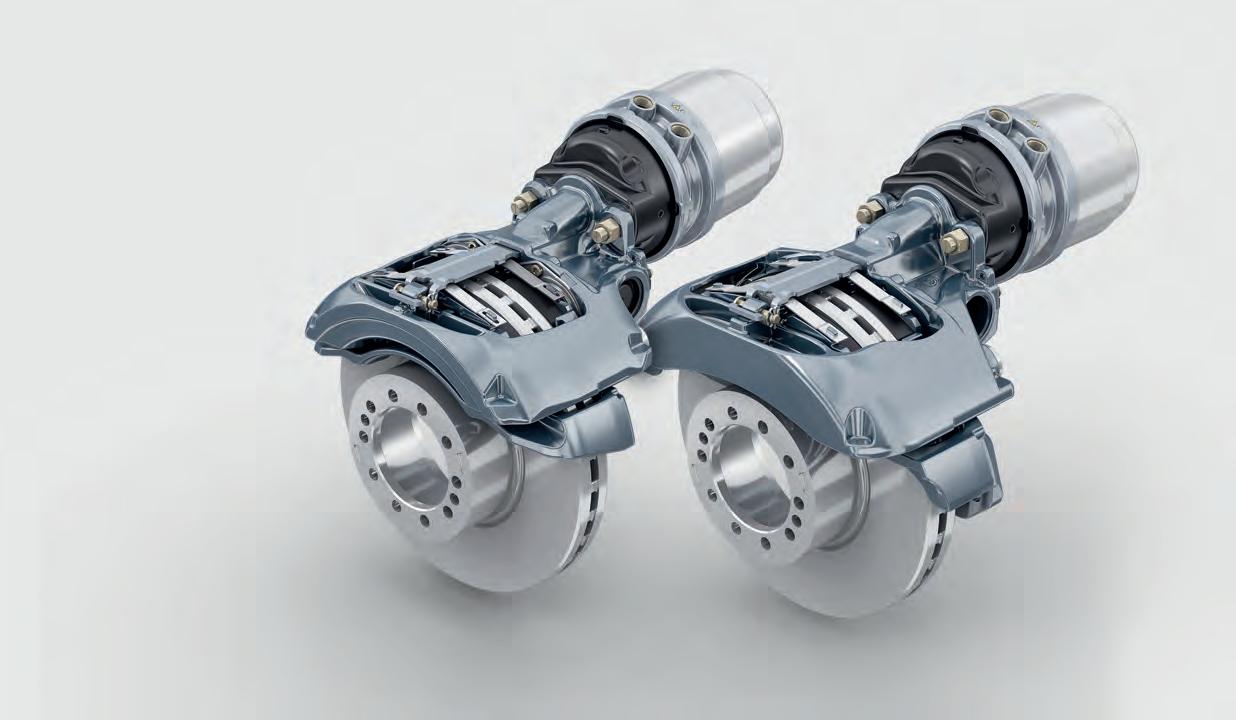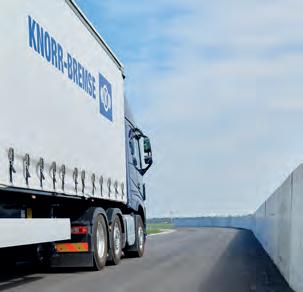
12 minute read
INTERMODAL INSIGHT
EFFICIENCIES ENCOURAGING INTERMODAL
SCHMITZ CARGOBULL HAS EXPANDED ITS SKEL RANGE AS A RESULT OF SEEING A RESURGENCE IN THE EUROPEAN MARKET FOR VERSATILE, RELIABLE CONTAINERISED FREIGHT OPTIONS.
Container transport is regarded as the backbone of global supply chains because all packaged goods arrive by container into European sea ports, according to Schmitz Cargobull. The German OEN emphasises that flexibility and speed, above all, is what matters with commercial transport.
“Container chassis are a key component of the solution in combined road and rail transport,” Schmitz Cargobull Chair, Andreas Schmitz, explains. “This is precisely why we are once again bringing back the S.CF container chassis semi-trailer into our range.”
From 2019 onwards, orders will be produced using three S.CF range standard container chassis, developed by Schmitz Cargobull and supplied by Turkish partner, Mersin-based, Koluman Otomotiv Endüstri.
Current data reportedly underlines the fact that containers will also continue to play a key role in the global transport of goods in the future: 38 million containers are currently in circulation worldwide – 98 percent of all packaged goods arrive at or leave Germany’s largest sea port, Hamburg, by container. And the current RWI/ISL Container Handling Index (Leibniz Institute for Economic Research and the Institute for Shipping Economics and Logistics) peaked in October 2018 at 134.6 points.
“In this current climate and in response to our customers’ wishes, we decided to re-introduce the container semi-trailer chassis into our product range,” Andreas Schmitz says.
The demand for container chassis seriously declined during the economic and financial crisis of 2008/2009. Schmitz Cargobull ceased production due to substantial overcapacity in the market.
“Demand has now recovered,” according to Sales Director, Boris Billich.
“We are seeing an annual market volume of between 9,000 and 12,000 vehicles per year.
“Schmitz Cargobull will offer three vehicles from the S.CF range: S.CF Gooseneck 45‘ Euro Light, S.CF Gooseneck 45‘ Euro and S.CF Gooseneck 40‘ LX. Our key markets are Germany, the Netherlands, Belgium and Scandinavia. However, the vehicles will be available everywhere. Sales, configuration and customer service will be fully handled by Schmitz Cargobull,” he says.
Andreas Schmitz reports that the OEM will handle the research and development of the new container chassis. “We have found a competent production partner in Koluman Otomotiv Endüstri and concluded a cooperation agreement with them,” he says – adding that the production volume is set to be 1,000 units per year by 2021.
Koluman Otomotiv Endüstri is also a partner of Daimler and has many years of experience in the production of commercial vehicles.
“We regard our trust-based cooperation with Schmitz Cargobull very positively,” Kaan Saltik, Chairman of Koluman Otomotiv Endüstri, says. “Our common values and quality standards are an excellent prerequisite for an efficient partnership.”
Andreas Schmitz: “The production process will be fully configured to meet our standards to guarantee the quality customers have come to expect from us. Our customers will receive genuine Schmitz Cargobull vehicles.” www.cargobull.com
FAST FACT German OEM, Schmitz Cargobull, is expanding its semi-trailer container chassis range with three gooseneck variants. The S.CF Gooseneck 45’ Euro, S.CF Gooseneck 45’ Euro Light and S.CF Gooseneck 40’ LX are reportedly characterised by easy operation, low maintenance and high availability.

MOVING WITH THE TIMES
RECENT STUDIES SUGGEST THAT LAST MILE SAME DAY DELIVERY DEMAND WILL BRING RADICAL CHANGE TO HOW THIRD-PARTY LOGISTICS PROVIDERS OPERATE.
Anew retail study in the US has confirmed the growing appetite for same day delivery among consumers is transforming the landscape for third party delivery.
The study by technology consultant, Capgemini, surveyed over 2,870 consumers and 500 supply chain executives, entrepreneurs and industry leaders and revealed that grocery delivery was a major growth area in which 55 per cent of customers said retail stores that could provide two-hour delivery times after purchase would increase their brand loyalty.
Only 19 per cent of stores were able to currently meet the demand. More than half the stores (59 per cent) offered a delivery time frame of more than three days. Only one per cent of online customers are willing, according to the study, to absorb the total cost of last mile deliveries. At current retail firms charge online customers 80 per cent of the overall delivery cost.
Another survey released by the National Retail Federation found that 75 per cent of consumers surveyed expect delivery to be free. A sharp rise on 68 per cent of consumers surveyed the previous year. This expectation included orders as low and under $50 (€44).
With the freight task expected to grow worldwide one key takeaway from the study for transport companies was that 74 per cent of satisfied consumers planned to increase purchase levels by as much as 12 per cent with a preferred retailer.
Investments were also on the rise in delivery innovations in grocery as companies looked to meet consumer demand. In the UK, Ocado, an online retailer, was working with companies in the US, France, Canada and Sweden to build automated customer fulfilment centres for the processing and packing of online orders.
The Capgemini study cited the recent launch by Walmart of its pilot run of its crowd sourced last mile grocery delivery platform and Target’s $550 million buyout of Shipt, an online, same-day delivery start-up – one of the largest acquisitions in the retail company’s history.
Since October 2018, venture capital firms have invested $US3.5 billion (€3.1 billion) in food and grocery delivery services. Ford, Walmart and delivery service Postmates are working in collaboration to tailor a service for delivering groceries and other goods to Walmart customers using autonomous vehicles by 2021.
“We’re always looking for the best ways to serve customers, so we’re exploring a number of different options for getting groceries from our stores to the customer’s front door – some in-house, some thirdparty,” said Tom Ward, Walmart Digital Operations Vice President in a statement last September.
As the costliest link in the supply chain last mile delivery under its current model was not sustainable for retail businesses as organisations were absorbing some of the costs enough to erode profits.
The Capgemini study found that 64 per cent of consumers are indifferent to whether delivery is made by a retail store’s employees, private individuals and thirdparty couriers. For an incentive, 55 per cent are willing to deliver products to neighbours in their vicinity. Up to 79 per cent of these are willing to deliver groceries at a price that is less than the cost incurred by retailers to deliver it themselves.
Capgemini estimates that should 44 per cent of customers deliver for other customers profit margins, as retailer delivery costs are lowered, will rise by 29 per cent. As many as 89 per cent of retailers
were considering joining forces with other retailers to create a shared delivery platform for last mile delivery through crowdsourcing.
Marshall Hughes, Founder and CEO of crowdsourcing start-up Passel in Australia, believes consumers are willing to make last mile delivery a part of their daily lives.
“Shoppers should not be delivery agents,” he says.
“Hughes believes that consumers are willing to make this part of their daily lives, rather than being seen as delivery agents.
“Shoppers should not be delivery agents. Rather than getting shoppers to do a delivery job, we offer to pay them to go home anyway and drop a package in their street. We think that’s the key difference.”
Meanwhile, e-commerce trends indicate that the average length of truck trips are shrinking. Emerging shopping trends are changing the face of the trucking industry, with the growth of last mile delivery cutting the average trucker’s trip length by 37 per cent since 2000, according to an industry study.
Just as the average trucking haul distance has shrunk, the number of truck trips and urban vehicle miles travelled have increased for much of the same 19-year period, thanks to an increase in more regionalised retail supply chains and the proliferation of urban last-mile deliveries, the American Transportation Research Institute (ATRI) said.
The ATRI report — E-Commerce Impacts on the Trucking Industry —also revealed that retailers are becoming more flexible in how they transact with consumers by decentralizing their distribution and fulfillment networks to bring inventory closer to consumers. That trend has resulted in a total of 2,130 fewer department stores and 385,000 fewer jobs at those stores in 2017 compared to 2015, ATRI said.
Even as store jobs have disappeared, courier jobs have expanded to take their place. There were 1,937 more courier services operating and just over 85,000 new employees hired in the sector between 2015 and 2017, the ATRI study found.
The loss of department stores has also been offset by the growth of “last-mile fulfillment centers,” which represented 73 percent of the industrial real estate market in 2017, a 15 per cent increase from the previous year.
“ATRI’s research provides a critical roadmap for trucking industry stakeholders to address the challenges and benefits of e-commerce and omnichannel retailing,” Tom Benusa, CIO of Eagan, Minn.-based trucking company Transport America, said in a release. “These trends are game-changing, and our industry must adapt quickly to ensure that trucking continues to be the preeminent freight mode.”
While last mile distribution facilities consolidate for greater operational efficiencies, couriers and logistics providers are turning to zero emission fleet alternatives.
The United States Postal Service (USPS) has begun using a fleet of all-electric delivery trucks in a move to cut emissions, save fuel, and reduce maintenance costs in its Fresno, California market.
USPS accepted the first of a planned seven

Bob Black Australia Post Group Chief Operating Officer
Ford E-450 based all-electric step vans, according to the vendor, Motiv Power Systems, a provider of all-electric fleet chassis for trucks and buses.
As compared to their combustion engine-powered counterparts, Motiv’s all-electric EPIC chassis-equipped mail delivery vans are expected to save fuel and maintenance costs, resulting in an overall reduction of total cost of ownership, Motiv said.
The pilot program of seven vans is slated for deployment in California’s Central Valley, according to Motiv. The first vehicle now serves routes in Fresno, with the balance of the vehicles to be deployed in Fresno and Stockton as part of a year-long program.
Most of the immediate project benefits will accrue in the San Joaquin Valley, an economically disadvantaged area with some of the highest pollution burdens in the country, as evidenced by CalEnviroScreen scores within the worst five percent in the state, according to Motiv.
The USPS’ acquisition of the Motiv chassis-powered vans was developed as a partnership by CALSTART and the San Joaquin Clean Transportation Center and funded through a California Air Resources Board (CARB) award to the San Joaquin Air Quality Control. The funds are meant to provide an incentive to Californian fleets to adopt the cleanest emerging technologies and continue to advance California’s Air Quality and Climate goals.
Postal service company Australia Post, is set to make it as Australia’s largest electric vehicle fleet operator, following an order for an additional 1,000 three-wheeled electric delivery vehicles (eDVs).
Australia Post Group Chief Operating Officer, Bob Black, said the 1,000 eDVs boost its existing fleet of electric postie vehicles – including electric pushbikes – and creates a range of benefits for posties, customers and the environment.
“We are proud to soon be operating Australia’s largest fleet of electric vehicles, and hope this will set the standard across Australia,” said Black.
“With parcel volumes growing – on average, close to 10 per cent each year for the last three years – and letter volumes declining, we’re always looking for ways to ensure our posties continue to play an important and sustainable role in the community.
“These vehicles offer additional carrying capacity, so our posties can deliver more parcels than ever before directly to the customer’s door – and can perform additional functions, such as collecting mail from street posting boxes.”
Along with the additional 1,000 eDVs Australia Post will also roll out an additional 4,000 electric pushbikes, bringing its total to 5,980 over the next three years.
Another factor that complicates last mile delivery is increasing urbanisation. With over 600 million more people forecast to live in urban environments by 2030 and new technologies creating opportunities for both service enhancement and disruption, online retailers and their logistics partners are being challenged to embrace bold new approaches in order to survive and compete. In the white paper, Shortening the Last Mile: Winning Logistics Strategies in the Race to the Urban Consumer, DHL and Euromonitor have identified the four main trends that are shaping urban last mile transportation – localised delivery, flexidelivery networks, seasonal logistics and evolving technologies – and ways in which companies can adapt their supply chains to the changing market environment and achieve competitive advantage.
“The last mile is increasingly becoming the key battleground in the e-commerce supply chain, and companies will have to develop targeted strategies in this area to compete effectively,” according to DHL Chief Commercial Officer, Katja Busch.
“It’s not just about transportation, but about companies’ overall approach to managing inventory – getting the right items to the right place at the right time. DHL is developing focused solutions to help e-commerce companies reach their end customers quickly and efficiently, from using machine learning to better route shipments within cities to adding more automation to our delivery networks.”
The white paper found that the major urban trends all create various challenges in terms of cost, service impact and organisational strain. For example, the growth of seasonal logistics as a result of increasingly popular holidays and promotional days such as Asia’s Singles’ Day or national Cyber Days, places significant pressure on logistics companies to build up additional capacity and hire resources to cope with short-term volume surges, which can in turn be difficult to predict. Urban customers’ demands for speed and convenience are forcing retailers to overhaul their warehousing networks, replacing centralised networks with local fulfilment and distribution infrastructure, which can require more accurate balancing of inventory. www.globaltrailer.com
Efficiency runs in the family.





THE IDEAL SOLUTION FOR EVERY TRAILER WHEELEND: THE ST7 AND THE ST6. With their potential to reduce weight and minimize downtimes, wheelends can play a valuable part in making your fleet even more efficient. With the trailer-specific two-piston ST7 brake, Knorr-Bremse set new standards in the 22.5-inch wheel segment. The identically designed ST6 version for compact wheelends is extending the success story to 19.5-inch applications. Tipping the scales at less than 32 kilograms, the ST6 is a real lightweight, enabling you to save fuel and/or increase the payload. | www. knorr-bremseCVS.com |








